[Spring Security] AuthenticationFilter 흐름 확인하기
인증 흐름
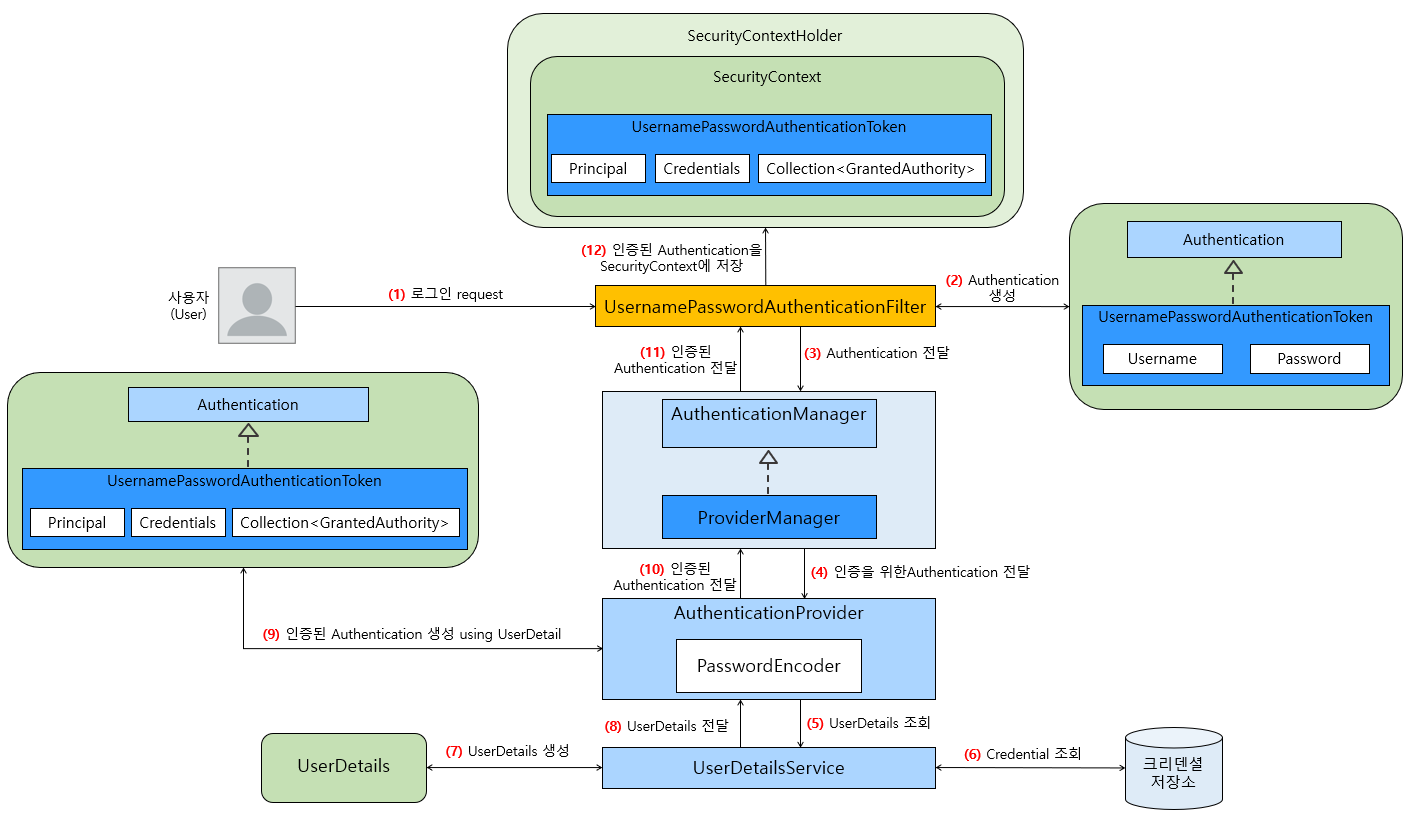
인증 흐름의 구성은 위와 같습니다. 코드 레벨에서 자세히 보겠습니다.
UsernamePasswordAuthenticationFilter
현재 스프링 시큐리티의 FilterChainProxy 에 등록된 필터는 아래와 같습니다.
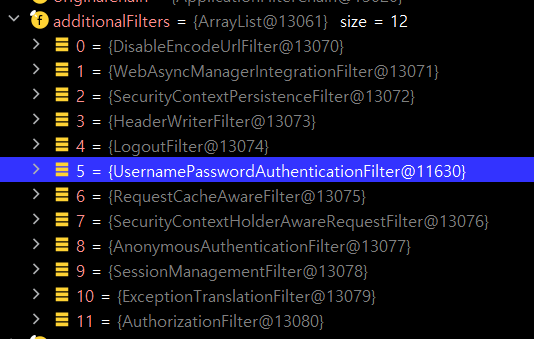
UsernamePasswordAuthenticationFilter 는 5번째로 실행되는 필터입니다.
먼저 해당 필터의 doFilter() 가 실행됩니다. UsernamePasswordAuthenticationFilter 는 직접 doFilter() 는 확장하지 않고 부모클래스인 AbstractAuthenticationProcessingFilter 의 doFilter() 를 사용합니다.
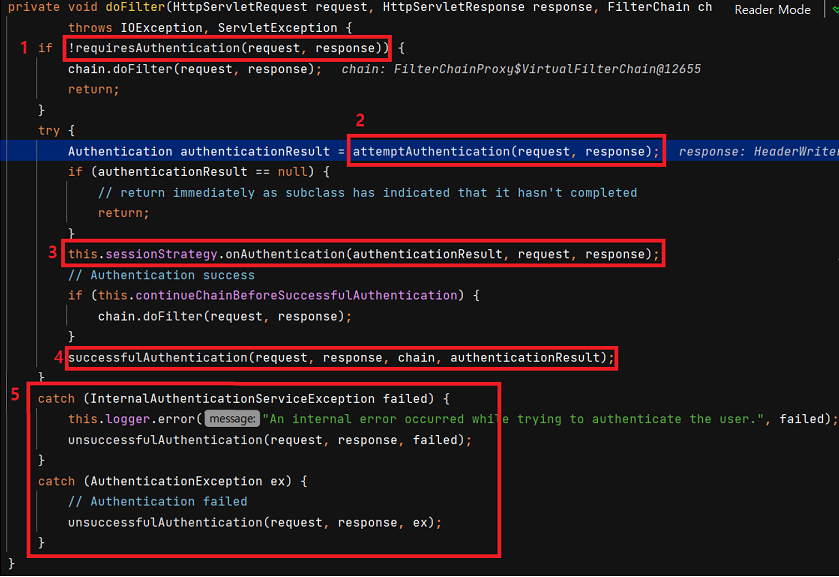
-
requiresAuthentication()메서드는 로그인 페이지에서의 요청인지 확인합니다. 해당 요청이 맞으면 필터를 계속 진행합니다. 아니면 다음 필터로넘어갑니다. 해당 값은SecurityConfig의http.loginPage("/loginPage")설정에 따라 변경가능합니다.
-
attemptAuthentication()메서드는 로그인 정보는 통해 인증정보인Authentication을 만듭니다.UsernamePasswordAuthenticationFilter에서는UsernamePasswordAuthenticationToken으로 만듭니다. 해당Authentication은 나중에 실제 인증에 사용됩니다. 그리고AuthenticationManager의authenticate()를 호출합니다. 해당 메서드는 후술하겠습니다.
UsernamePasswordAuthenticationToken.unauthenticated()메서드는 권한 정보가 없는 객체 생성 메서드이고, 반대로authenticated()는 권한 정보가 있는 객체 생성 메서드입니다.
-
세션 고정 보호 정책에 따른 세션ID 변경입니다. 매 요청마다 세션 ID 를 변경하여 세션 고정 공격에 대해 보호할 수 있도록 합니다. 기본정책은
ChangeSessionIdAuthenticationStrategy으로, 로그인 시마다 세션ID 를 변경합니다. 아래 로직은 세션 정책을 가진CompositeSessionAuthenticationStrategy의onAUthentication()메서드입니다.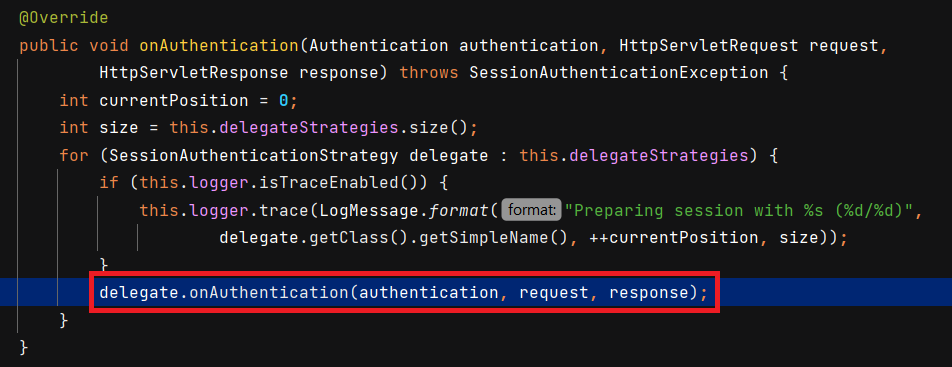
- 위 빨간 박스에서 delegate 가
ChangeSessionIdAuthenticationStrategy입니다.
- 위 빨간 박스에서 delegate 가
-
인증 성공 시
successfulAuthentication()메서드를 호출합니다. 해당 메서드는SecurityContext안에 인증 결과인Authentication를 담아서SecurityContextHolder로 감쌉니다. 이제 해당ThreadLocal에서Authentication을 조회할 수 있게 됩니다.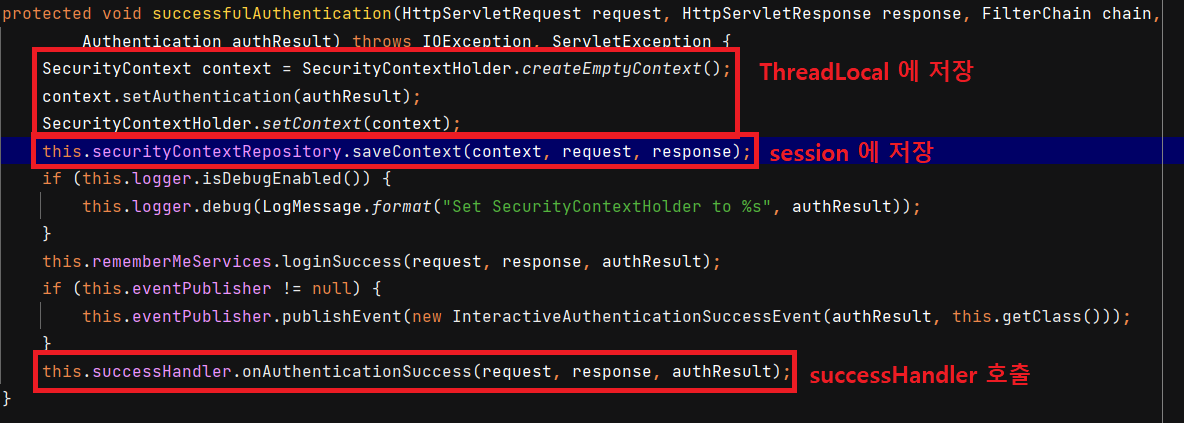
- 또한
session에서도 접근할 수 있게 저장해둡니다. - 마지막으로
successHandler를 호출합니다. 해당 핸들러는 설정 파일인SecurityFilterChain에서.successHandler()로 커스텀할 수 있습니다.
- 또한
-
Exception 발생 시 호출됩니다.
unsuccessfulAuthentication()이 호출됩니다. 해당 핸들러 안에서failureHandler가 실행됩니다. 해당 핸들러도 마찬가지로 설정 파일인SecurityFilterChain에서.failureHandler()로 커스텀할 수 있습니다.
ProviderManager
위 2번 과정의 attemptAuthentication() 메서드 내부에서 this.getAuthenticationManager().authenticate(authRequest) 안으로 들어가보겠습니다. 길어서 필요한 부분만 보겠습니다.
해당 메서드는 ProviderManager 에 있는 메서드입니다. ProviderManager 는 여러 AuthenticationProvider 를 가지면서 해당 Authentication 객체를 인증할 수 있는 Provider 를 선택해서 인증을 위임합니다.
아래는 ProviderManager 의 authenticate() 메서드입니다.
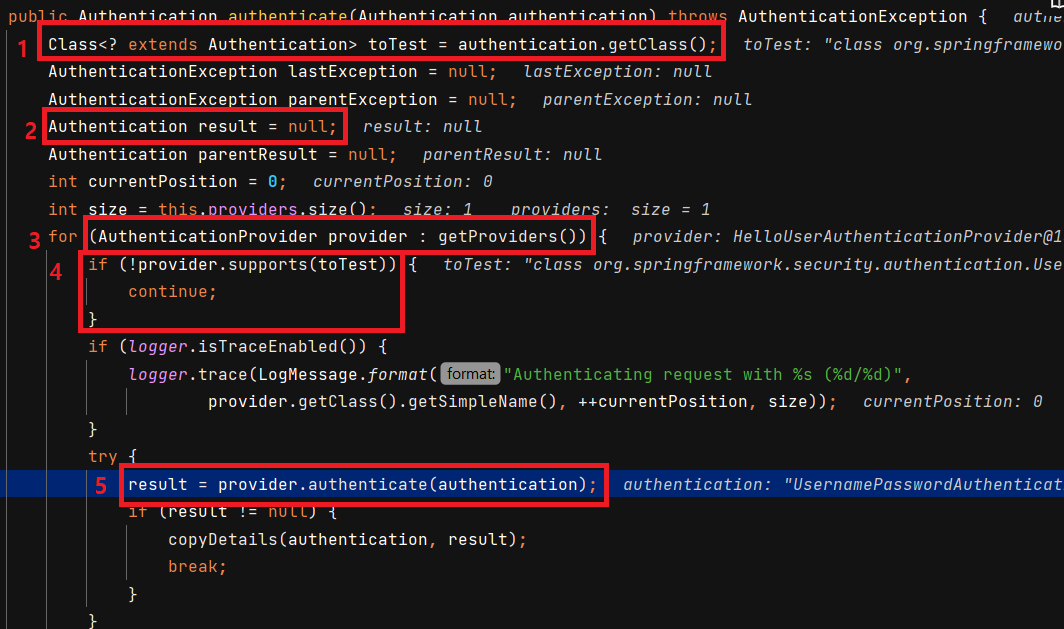
-
받은
Authentication의 클래스입니다.Authentication은 인터페이스이며 여러 구현체가 있는데, 각 구현체마다 처리할 수 있는Provider가 있기 때문에 미리toTest객체를 선언하고 어떤 클래스인지 할당합니다. -
실제로 반환할
Authentication객체를result로 선언합니다. -
getProviders()는ProviderManager가 가지고 있는Provider의 목록입니다. 하나씩 순회하며 전달받은Authentication에 맞는Provider를 찾습니다. -
provider.supports()메서드는 해당Provider가 전달받은Authentication를 처리할 수 있는지 확인하는boolean값입니다.
-
선택된
Provider가 인증을 수행하는 로직입니다. 아래에서 설명하겠습니다.
AuthenticationProvider
AuthenticationProvider 는 인터페이스이며 해당 인터페이스를 구현한 구현체가 빈으로 등록되면 사용할 수 있습니다. UsernamePasswordAuthenticationToken 은 기본적으로 DaoAuthenticationProvider 를 사용합니다.
아래는 DaoAuthenticationProvider 의 추상 클래스인 AbstractUserDetailsAuthenticationProvider 의 authenticate() 메서드입니다. 먼저 UserDetails 를 얻는 로직입니다.
사용자 아이디 검증
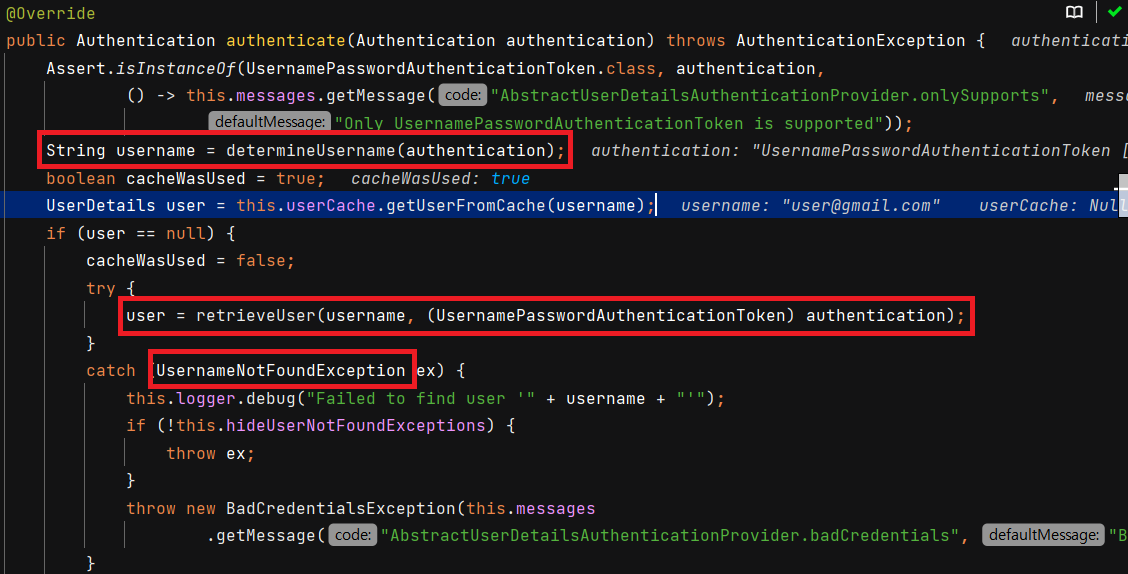
-
determineUsername()으로Authentication에 있는name을 얻습니다. -
retrieveUser()메서드는username을 통해 DB 혹은 인메모리에서user를 조회하고UserDetails로 반환합니다.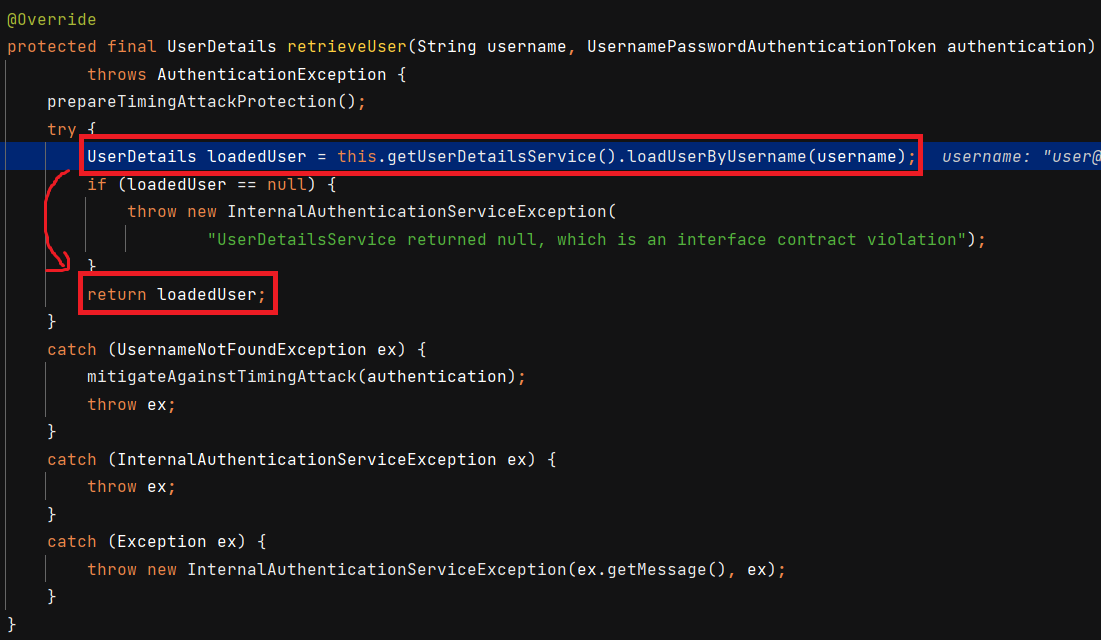
UserDetails는UserDetailsService에서loadUserByUsername()메서드로 얻습니다.UserDetailsService는 인터페이스로, 빈으로 등록된UserDetailsService가 사용되거나 인메모리사용 시InMemoryUserDetailsManager가 사용됩니다.- 만약
username으로 조회되는 데이터가 없다면UsernameNotFoundException을 발생시킵니다.
이렇게 얻은 UserDetails 에는 기본적으로 username, password, authorities 가 있습니다.
사용자 비밀번호 검증
비밀번호도 AuthenticationProvider 의 authenticate() 메서드 내에서 이루어집니다. 해당 메서드 내 일부입니다.

위 코드처럼 additionalAuthenticationChecks() 메서드에 UserDetails user 와 authentication 객체를 넘깁니다.
아래는 DaoAuthenticationProvider 의 additionalAuthenticationChecks() 메서드입니다.
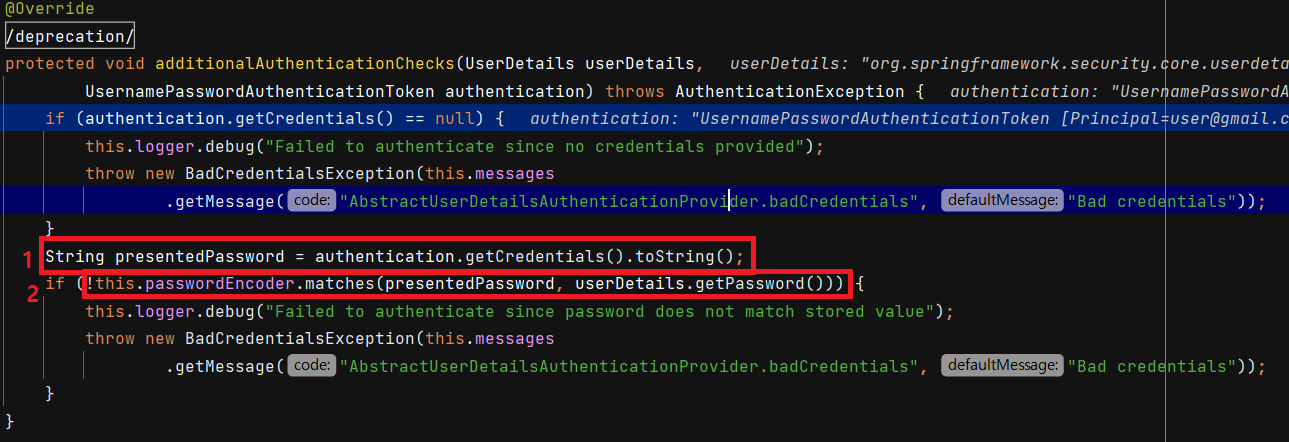
- 먼저
Authentication에서 비밀번호를 추출합니다. 여기서 유의해야 할 건Authentication은 요청으로부터 얻은 정보로 생성된 객체입니다. - 그리고
userDetails에 있는 비밀번호와 비교합니다.userDetails는 DB 에서 얻은 정보입니다. 만약 다르다면BadCredentialsException이 발생합니다.
Authentication
사용자의 인증 정보를 저장하는 토큰 개념으로. 인증 시 id 와 password 를 담고 인증 검증을 위해 전달되어 사용됩니다. 인증 후에는 최종 인증 결과 (user 객체, 권한정보) 를 담고 SecurityContext 에 저장되어 전역적으로 참조가 가능합니다.
아래와 같은 필드 값을 가집니다.
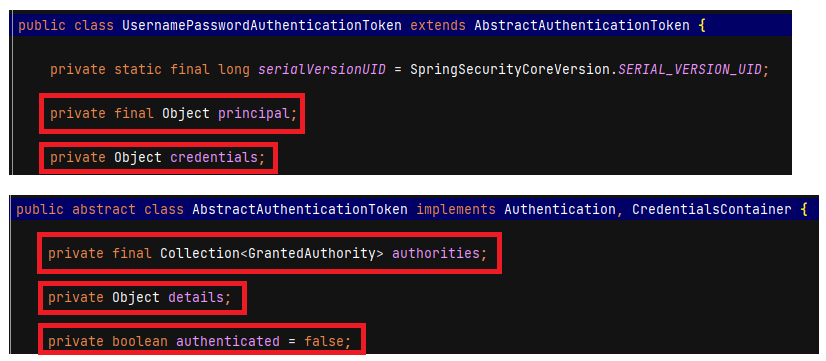
UsernamePasswordAuthenticationToken 은 AbstractAuthenticationToken 을 확장합니다. 필드값의 의미는 다음과 같습니다.
- principal : 사용자 아이디 혹은 User 객체를 저장
- credentials : 사용자 비밀번호
- authorities : 인증된 사용자의 권한 목록
- details : 인증 부가 정보
- Authenticated : 인증 여부
ThreadLocal 에 담긴 Authentication 객체 꺼내기
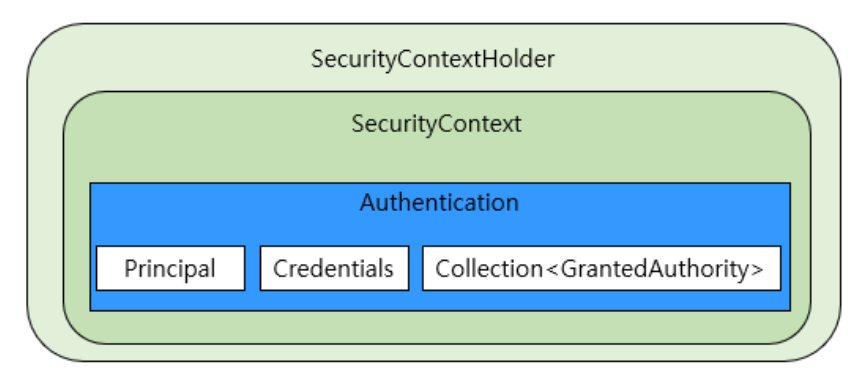
기본적으로 모든 위치에서 SecurityContexHolder.getContext().getAuthentication() 로 Authentication 을 얻을 수 있습니다. 그 이유는 ThreadLocal 에 저장되어 있기 때문입니다.
인증 성공 이후에 인증 필터인 AbstractAuthenticationProcessingFilter 의 successfulAuthentication() 메서드에서 SecurityContext 에 해당 Authentication 객체를 저장하고, 또한 세션에도 저장을 했습니다. 이제 해당 Authentication 을 꺼내보겠습니다. SecurityContextHolder 에서 꺼내는 방법과 세션에서 꺼내는 방법 두 가지가 있습니다.

위 코드는 "/" 으로 매핑했을 때입니다. 두 방법으로 Authentication 을 받아도 둘 다 같은 인스턴스를 반환합니다.
Authentication Flow
인증처리를 시작하는 시작 단계부터 각각의 인증 단계를 거쳐서 인증이 완료되는 흐름을 전체적으로 정리해보겠습니다.
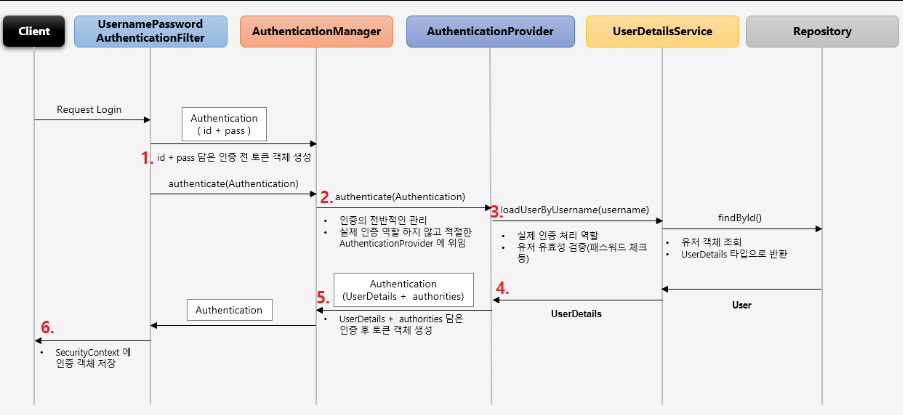
UsernamePasswordAuthenticationFilter가Authentication객체를 생성해서AuthenticationManager에게 인증을 위임합니다. (attemptAuthentication()내의authenticate())AuthenticationManager은 인증의 전반적인 관리를 하지만 실제 인증역할은 하지 않습니다. 대신 내부적으로 가지고 있는List안의AuthenticationProvider중, 현재 인증에 사용되는AuthenticationProvider를 찾아서 (support()사용) 인증을 위임합니다. (authenticate())AuthenticationProvider는 전달받은Authentication을 통해UserDetailsService로 유저 객체를 요청합니다. (loadUserByUsername())UserDetailsService는 DB 에서 유저 객체를 조회합니다. 이때 예외가 발생하면 인증에 실패하게 되고, 그 예외는UsernamePasswordAuthenticationFilter가 받아서 처리하게 됩니다. 인증에 성공하면UserDetails타입으로 반환합니다.AuthenticationProvider는 ID 가 검증된UserDetails에서 PW 를 검증합니다. (additionalAuthenticationChecks()) PW 가 일치하지 않으면BadCredentialException이 발생합니다. 검증이 완료되면Authentication에UserDetails와authorities를 담은 객체를 생성하여 반환합니다.- 최종적으로
UsernamePasswordAuthenticationFilter는SecurityContext에 인증 객체를 저장합니다. (successfulAuthentication())



댓글남기기